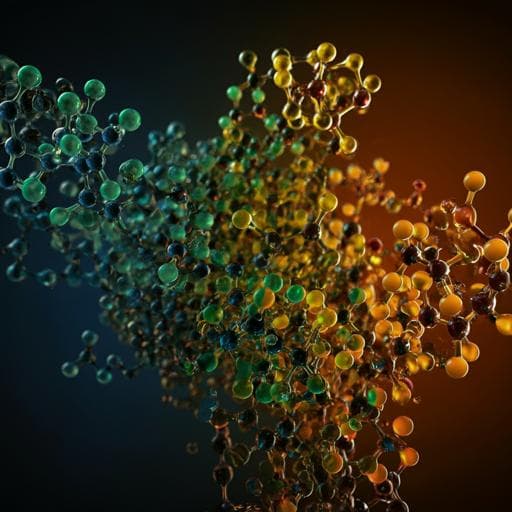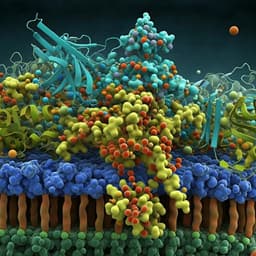
Biology
Enzymatic kinetic resolution of desmethylphosphinothricin indicates that phosphinic group is a bioisostere of carboxyl group
D. D. Biase, F. Cappadocio, et al.
Discover how Escherichia coli glutamate decarboxylase (EcGadB) transforms a unique phosphinic analog of glutamate into a metabolite with promising implications for prodrug design. This fascinating research was conducted by Daniela De Biase, Francesca Cappadocio, Eugenia Pennacchietti, Fabio Giovannercole, Antonio Coluccia, Jouko Vepsäläinen, and Alex Khomutov.
~3 min • Beginner • English
Introduction
Glutamate decarboxylase (GadB; EC 4.1.1.15) from Escherichia coli catalyzes the irreversible decarboxylation of L-glutamate to GABA and exhibits strict stereospecificity for the L-isomer. While EcGadB has been developed as a biocatalyst for GABA production, its activity toward glutamate analogues varies and is generally limited. Phosphonic and phosphinic amino acids are unusual natural products with C–P bonds that can mimic features of carboxyl or phosphate groups and have pharmaceutical relevance (e.g., fosfomycin, fosmidomycin, bialaphos). L-2-amino-4-(hydroxyphosphinyl)butyric acid (L-Glu-γ-PH; desmethylphosphinothricin) is a phosphinic analogue of glutamate and a biosynthetic intermediate in bialaphos pathways, but its enzymatic processing by glutamate-metabolizing enzymes was unknown. The study investigates whether L-Glu-γ-PH can act as an EcGadB substrate, enabling an enantioselective kinetic resolution of racemic D,L-Glu-γ-PH to access the previously unavailable D-enantiomer and to produce GABA-PH. It further tests whether downstream enzymes (GABase components) metabolize GABA-PH, providing insight into whether the phosphinic group functions as a bioisostere of the carboxyl group in enzymatic contexts. This has implications for biocatalysis, synthesis of bioactive phosphinic compounds, and prodrug design.
Literature Review
EcGadB is a well-characterized PLP-dependent enzyme active at acidic pH, responsive to chloride, and used as an immobilized biocatalyst for GABA production from abundant L-glutamate. Prior studies show EcGadB has narrow substrate specificity, with slow activity on certain glutamate analogues and no activity toward some phosphonic analogues. Phosphonate/phosphinate natural products exhibit diverse bioactivities; phosphinothricin inhibits glutamine synthetase by mimicking a reaction intermediate. L-Glu-γ-PH has similar potency to glutamate at group III metabotropic glutamate receptors and may have antibacterial activity, but its interactions with glutamate-metabolizing enzymes were not previously examined. Reports indicate α-phosphinic, but not α-phosphonic, amino acid analogues can be substrates for other PLP-dependent enzymes, suggesting potential bioisosterism of the phosphinic group. Conversely, γ-phosphonic glutamate analogues and phosphinothricin do not act on GadB, highlighting the need to test γ-phosphinic analogues specifically.
Methodology
Synthesis and materials: D,L-Glu-γ-PH was synthesized following established routes; L-Glu-γ-PH was prepared with modifications to a published protocol. Succinate-PH was synthesized and purified chromatographically. GABase (GABA-transaminase and succinic semialdehyde dehydrogenase from Pseudomonas fluorescens) and other reagents were commercially sourced. EcGadB was expressed, purified, and assayed using standard conditions.
Preliminary substrate testing: Substrate properties of D,L-Glu-γ-PH with EcGadB were probed by thin-layer chromatography (TLC) to detect a product with Rf similar to GABA, and by 1H NMR analysis of reaction mixtures to confirm formation of GABA-PH.
Molecular dynamics (MD) modeling: Using PDB 1PMM, external aldimine adducts PLP–L-Glu and PLP–L-Glu-γ-PH were modeled. Constant pH MD (pH 4.5) simulations were run with AMBER (1 ns production), analyzing RMSF and protein–ligand interactions. Protonation states for catalytic residues and cofactor were set to reflect acidic conditions. Binding interactions, distances (notably Lys276 ε-N to substrate Cα ~3.5 Å), and H-bond networks were compared between L-Glu and L-Glu-γ-PH adducts.
GABase coupling and 31P NMR: EcGadB reactions (pH 4.6 acetate buffer) converted D,L-Glu-γ-PH to GABA-PH, monitored by 31P NMR. Post-decarboxylation mixtures were treated with GABase (neutral/alkaline buffer) to convert GABA-PH to SSA-PH and then to Succinate-PH with concomitant NADPH production. 31P NMR spectra before and after GABase treatment identified phosphinic species and confirmed that NADPH formation arose from oxidation of the carbonyl of SSA-PH, with the P–H bond remaining intact.
Kinetics: EcGadB kinetics with L-Glu and L-Glu-γ-PH were measured using the GABase assay to quantify GABA or GABA-PH via NADPH formation at 340 nm (ε=6220 M−1 cm−1). Reactions were run at pH 4.6 in 0.1 M pyridine/HCl with DTT and PLP, quenched into HEPPS pH 8.6, and subsequently analyzed with GABase. Rates at varying substrate concentrations were fit to the Michaelis–Menten equation to obtain kcat and Km.
Enantioselective kinetic resolution and scale-up: Small-scale reactions (100 µL) with 0.4 M D,L-Glu-γ-PH and EcGadB at pH 4.6–5.0 monitored GABA-PH formation over 2 h via GABase assay. Preparative reactions (2.5 mL) were conducted under similar conditions (1 µg µL−1 EcGadB, pH controlled 4.6–5.4), with aliquots analyzed by real-time 31P NMR to follow depletion of Glu-γ-PH and formation of GABA-PH.
Isolation and purification: After EcGadB removal (ultrafiltration), ion-exchange chromatography (Dowex 50WX8, H+-form) separated products: water elution yielded crude D-Glu-γ-PH (contaminated with PLP), and 0.5 N HCl eluted GABA-PH hydrochloride, which was neutralized to the zwitterion and recrystallized. To remove PLP from D-Glu-γ-PH, the mixture was treated with N-(2-aminooxyethyl)putrescine (AOEPUT) to form a tightly retained PLP oxime on the resin, allowing elution of pure D-Glu-γ-PH. Structures and purity were confirmed by 1H, 13C, and 31P NMR; specific rotations were measured.
Antimicrobial testing: Minimum inhibitory concentrations (MIC90) for D,L-, L-, and D-Glu-γ-PH were determined by broth dilution against E. coli K-12 MG1655 in Minimal Medium EG with 0.4% glucose. OD600 was monitored over 24 h, and percent inhibition calculated to derive MIC90; ampicillin served as a control.
Controls and additional assays: Attempts to decarboxylate D-Glu-γ-PH with EcGadB confirmed lack of activity even upon overnight incubation. TLC verified that the γ-phosphonic analogue is not an EcGadB substrate.
Key Findings
- EcGadB decarboxylates the L-isomer of D,L-Glu-γ-PH to produce GABA-PH, while leaving the D-isomer unreacted, enabling an enzymatic kinetic resolution.
- MD simulations showed that PLP–L-Glu-γ-PH adopts a binding mode in EcGadB similar to PLP–L-Glu, with analogous H-bonding to active-site residues, supporting substrate compatibility of the phosphinic analogue.
- GABase converts GABA-PH to SSA-PH and then oxidizes it to Succinate-PH with NADPH formation. 31P NMR confirmed identities of D,L-Glu-γ-PH, GABA-PH, and Succinate-PH and demonstrated that NADPH arises from oxidation of the aldehyde (carbonyl) of SSA-PH, with the P–H bond remaining intact.
- Kinetic parameters (pH 4.6, pyridine/HCl buffer):
• L-Glu: kcat = 78.18 ± 2.06 s−1; Km = 0.84 ± 0.09 mM; kcat/Km = 92.85 ± 10.26 s−1 mM−1.
• L-Glu-γ-PH: kcat = 13.93 ± 0.58 s−1; Km = 39.82 ± 5.66 mM; kcat/Km = 0.35 ± 0.05 s−1 mM−1.
EcGadB is >200-fold less efficient with L-Glu-γ-PH than with L-Glu, primarily due to a >40-fold higher Km.
- Small-scale kinetic resolution: From 0.4 M D,L-Glu-γ-PH, GABA-PH reached 0.197 M at 2 h (~quantitative conversion of the 0.200 M L-isomer); ~50% of the racemate remained, consistent with exclusive L-isomer decarboxylation.
- Preparative scale (2.5 mL): Real-time 31P NMR showed GABA-PH reached 93% of the theoretical value by 3 h and 98.2% by 5 h. Downstream purification yielded D-Glu-γ-PH (preparative yield 73%) and GABA-PH identical to a chemical standard by NMR, TLC, and melting point.
- Stereochemistry: D-Glu-γ-PH displayed [α]20D = −20.4° (c 1.0, H2O), opposite in sign and similar magnitude to L-Glu-γ-PH ([α]20D = +20.9°, c 1.0, H2O). D-Glu-γ-PH was not a substrate of EcGadB.
- Antimicrobial activity (MIC90 against E. coli K-12 MG1655): L-Glu-γ-PH = 7 µg mL−1; D,L-Glu-γ-PH = 14–20 µg mL−1; D-Glu-γ-PH = not detectable; ampicillin = 4 µg mL−1. Thus, antibacterial activity resides in the L-isomer.
Discussion
The study set out to test whether the phosphinic group can function as a bioisostere of the carboxyl group in enzymatic transformations. The results demonstrate that EcGadB recognizes and decarboxylates L-Glu-γ-PH, closely paralleling L-glutamate binding in the active site, and that the resulting GABA-PH is further processed by GABA-transaminase and NADP+-dependent succinic semialdehyde dehydrogenase to Succinate-PH without oxidation of the P–H bond. These findings confirm that both PLP-dependent and NADP+-dependent enzymes can accept phosphinic substrates when the overall charge and geometry mimic those of carboxylates, supporting the bioisostere hypothesis. The enantioselective decarboxylation enables an efficient kinetic resolution of racemic D,L-Glu-γ-PH into bioactive GABA-PH and previously unavailable D-Glu-γ-PH, providing an accessible route to these compounds. The observed higher Km for L-Glu-γ-PH relative to L-Glu aligns with subtle differences in distal group anchoring seen in MD modeling. The antimicrobial assays clarify that only the L-enantiomer contributes to antibacterial activity, informing development and evaluation of phosphinic antibacterials. More broadly, the work suggests that intracellular metabolism of phosphinic compounds could generate downstream bioactive metabolites, opening opportunities for prodrug strategies.
Conclusion
This work shows that the phosphinic group can act as a bioisostere of the carboxyl group in enzyme-catalyzed reactions: EcGadB stereospecifically decarboxylates L-Glu-γ-PH to GABA-PH, and GABase further converts it to Succinate-PH while preserving the P–H bond. Leveraging EcGadB’s stereospecificity affords a simple, scalable kinetic resolution of D,L-Glu-γ-PH to generate D-Glu-γ-PH (73% preparative yield) and GABA-PH, the latter being a potent GABAB agonist. The findings validate enzymatic routes to phosphinic compounds and suggest that metabolic transformations of phosphinic substrates can be harnessed for synthesis and prodrug design. Future work should expand the enzyme panel (other PLP- and NAD(P)+-dependent enzymes), obtain structural co-crystals with phosphinic substrates to refine binding models, optimize reaction conditions in aqueous systems and immobilized formats for scale-up, and assess intracellular metabolism and therapeutic potential across diverse organisms.
Limitations
The study focuses on one PLP-dependent enzyme (EcGadB) and one NADP+-dependent dehydrogenase system (GABase), limiting generalizability across enzymes. Kinetic measurements were performed in pyridine/HCl buffer at acidic pH, which may not reflect physiological conditions and could affect kinetic parameters. No crystal structures with L-Glu-γ-PH were obtained; binding inferences rely on MD simulations. The catalytic efficiency toward L-Glu-γ-PH is substantially lower than for L-Glu, potentially constraining process efficiency without optimization. Antimicrobial testing was limited to E. coli K-12 and MIC90 determinations; broader spectrum and in vivo efficacy/toxicity were not evaluated. GABase is a crude enzyme preparation, and individual enzyme kinetics with phosphinic substrates were not deconvoluted.
Related Publications
Explore these studies to deepen your understanding of the subject.







